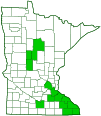squirrel corn
(Dicentra canadensis)
Conservation • Description • Habitat • Ecology • Use • Distribution • Taxonomy
Conservation Status |
|
|||||||
| IUCN Red List | not listed |
|||||||
| NatureServe | N5 - Secure S3 - Vulnerable |
|||||||
| Minnesota | Special Concern |
|||||||
Description |
||
Squirrel corn is a 4″ to 12″ tall, erect, perennial forb with a short rhizome that is covered with yellow, round or corn kernel shaped shaped bulblets. Usually 1 but sometimes 2 leaves and a flowering stalk arise from each bulblet. There is no central stem. The leaves are all basal. They are 4″ to 12″ long, but usually 5½″ to 9½″ long, 1½″ to 7″ wide, but usually 2⅓″ to 5½″ wide. They are on 2″ to 8⅔″ long, but usually 3″ to 6¼″ long, slender, often brown stalks. The leaves are divided into 3 primary leaflets. Each leaflet is again divided into 3 secondary leaflets. These secondary leaflets may be again divided into 3 tertiary leaflets. The ultimate leaflets (secondary or, if any, tertiary), are cleft into linear or narrowly oblong lobes, and end in a minute, abrupt tip. The margins are untoothed. The upper leaf surface is bluish green, hairless, smooth to the touch, and covered with a whitish, waxy coating (glaucous). The underside is hairless and glaucous. The inflorescence is a long, unbranched cluster of 3 to 12 flowers at the end of a flowering stalk (scape). The scape is slender, hairless, and leafless. It is 4″ to 12″ long, but usually 6″ to 10½″ long, arches at the tip, and usually extends above the leaves. The flowers are about ½″ long and ¾″ wide. They flowers hang downward on hairless flower stalks that are from a little over 1 ⁄16″ to ½″ long. There are 4 petals, the 2 inner petals white, the 2 outer petals white. The outer petals are pouch-like and have short, scarcely diverging nectar spurs with broadly rounded tips. The inner petals are much narrower, are united at the tips, and have small wings that curl upward. The flowers are fragrant. The fruit is a spindle-shaped capsule that tapers to a point at both ends. The capsules are 3 ⁄16″ to ⅔″ long, but usually ⅓″ to ½″ long, and ⅛″ to ¼″ wide. They contain several seeds. |
||
Height |
||
4″ to 12″ |
||
Flower Color |
||
White |
||
Similar Species |
||
Slender corydalis (Corydalis micrantha ssp. micrantha) flowers are yellow and have a single nectar spur. Dutchman’s breeches (Dicentra cucullaria) bulblets are more numerous, half as big, pink to white, and shaped like a tear-drop. There are usually 2 leaves per scape. The upper leaf surface is yellowish green, rough to the touch, and is not glaucous. The nectar spurs are long and widely diverging. The flowers are not fragrant. It is found throughout Minnesota except in the northeast. |
||
Habitat |
||
Moist. Deciduous woods. |
||
Ecology |
||
Flowering |
||
April to May |
||
Pests and Diseases |
||
|
||
Use |
||
|
||
Distribution |
||||
|
Sources |
|||
| 4/10/2023 | ||||
Nativity |
||||
Native |
||||
Occurrence |
||||
Uncommon |
||||
Taxonomy |
|||
| Kingdom | Plantae (Plants) | ||
| Subkingdom | Pteridobiotina | ||
| Phylum | Tracheophyta (Vascular Plants) | ||
| Class | Magnoliopsida (Dicots) | ||
Order |
Ranunculales (Buttercups, Poppies, and Allies) | ||
Family |
Papaveraceae (poppy) | ||
| Subfamily | Fumarioideae | ||
| Tribe | Fumarieae | ||
| Subtribe | Corydalinae | ||
Genus |
Dicentra (bleeding hearts) | ||
Tribe |
|||
Subordinate Taxa |
|||
Synonyms |
|||
| Bicuculla canadensis | |||
Common Names |
|||
| squirrel corn | |||
Glossary
Glaucous
Pale green or bluish gray due to a whitish, powdery or waxy film, as on a plum or a grape.
Linear
Long, straight, and narrow, with more or less parallel sides, like a blade of grass.
Rhizome
A horizontal, usually underground stem. It serves as a reproductive structure, producing roots below and shoots above at the node.
Scape
An erect, leafless stalk growing from the rootstock and supporting a flower or a flower cluster.
Visitor Photos |
|||||
Share your photo of this plant. |
|||||
| This button not working for you? Simply email us at info@MinnesotaSeasons.com. Attach one or more photos and, if you like, a caption. |
|||||
|
|||||
MinnesotaSeasons.com Photos |
|||||
|
|||||

Visitor Videos |
|||
Share your video of this plant. |
|||
| This button not working for you? Simply email us at info@MinnesotaSeasons.com. Attach a video, a YouTube link, or a cloud storage link. |
|||
Other Videos |
|||
| Squirrel Corn (Dicentra canadensis) wvoutdoorman |
|||
About
Published on Mar 26, 2012 I show the Squirrel Corn flower as well as what the root looks like to help you identify the plant |
|||

Visitor Sightings |
|||||
Report a sighting of this plant. |
|||||
| This button not working for you? Simply email us at info@MinnesotaSeasons.com. Be sure to include a location. |
|||||
|
|||||
MinnesotaSeasons.com Sightings |
|||||

|
Created: Last Updated: © MinnesotaSeasons.com. All rights reserved. |


